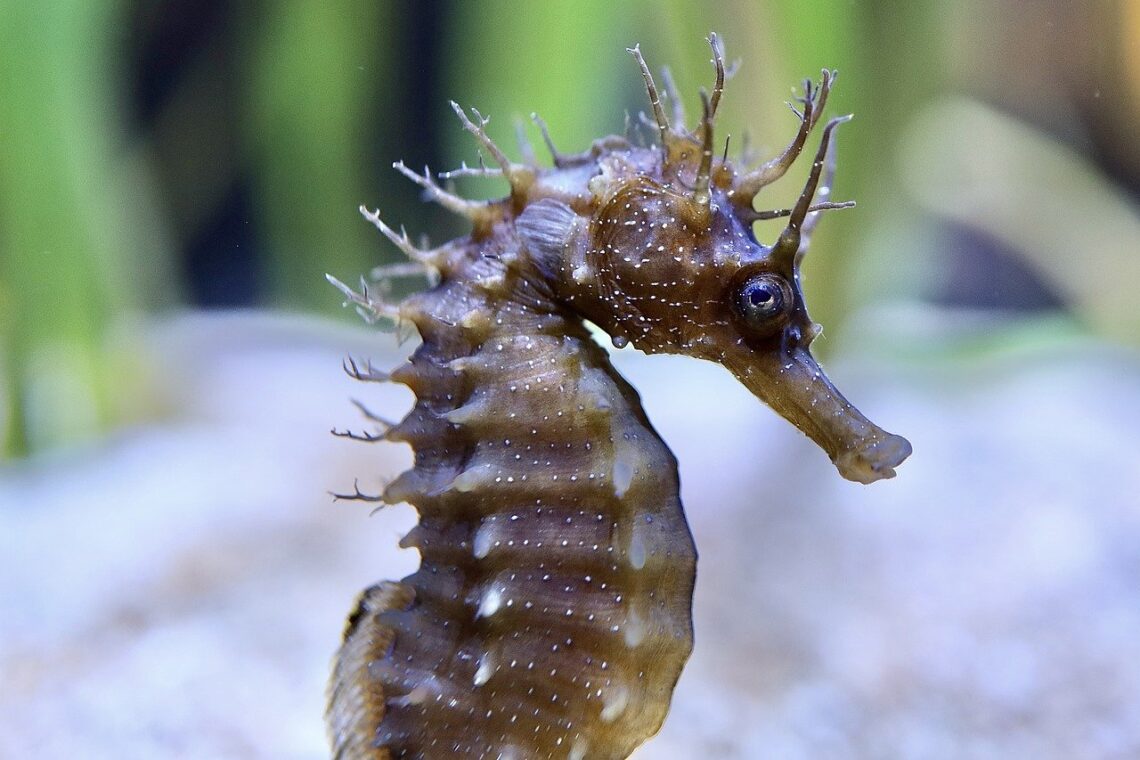
Fun Facts About Seahorses: Unlock The Best 32
Facts About Seahorses
Seahorses, belonging to the genus Hippocampus, are some of the most fascinating marine species. In fact known for their horse-like heads and prehensile tails, these sea creatures captivate the imagination of marine biologists and ocean enthusiasts alike. Despite being poor swimmers, seahorses have adapted to various marine environments, showcasing an array of unique behaviors and physical characteristics. Thus this article delves into interesting facts about seahorses, their anatomy, and their lifestyle, providing a comprehensive understanding of these extraordinary animals.
Unique Anatomy of Seahorses
Horse-Like Heads and Prehensile Tails
Indeed seahorses are easily recognizable by their distinctive horse-like heads, which contribute to their common name. Additionally, their prehensile tail allow them to anchor themselves to underwater plants and corals.
Therefore this adaptation is crucial for survival in their natural habitat, where strong currents are common. Their swim bladder also aids in buoyancy control, allowing them to maintain stability and float at different water depths effortlessly.
Dorsal Fin and Pectoral Fins
On the back of their heads, seahorses possess a small dorsal fin, which aids in their slow swimming. Despite having smaller pectoral fins on the sides of their heads, seahorses are considered poor swimmers.
Thus their small size and unique body shape make them vulnerable to predators, yet their ability to cling to sea grasses and corals provides a measure of safety.
Bony Plates and Spiny Appearance
Seahorses are covered in bony plates instead of scales, giving them a spiny appearance. This protective armor helps deter predators.
Furthermore, their elongated snouts are perfectly adapted for sucking up tiny pieces of food, such as small crustaceans and brine shrimp, which constitute their diet.
Reproductive Cycle and Brood Pouch
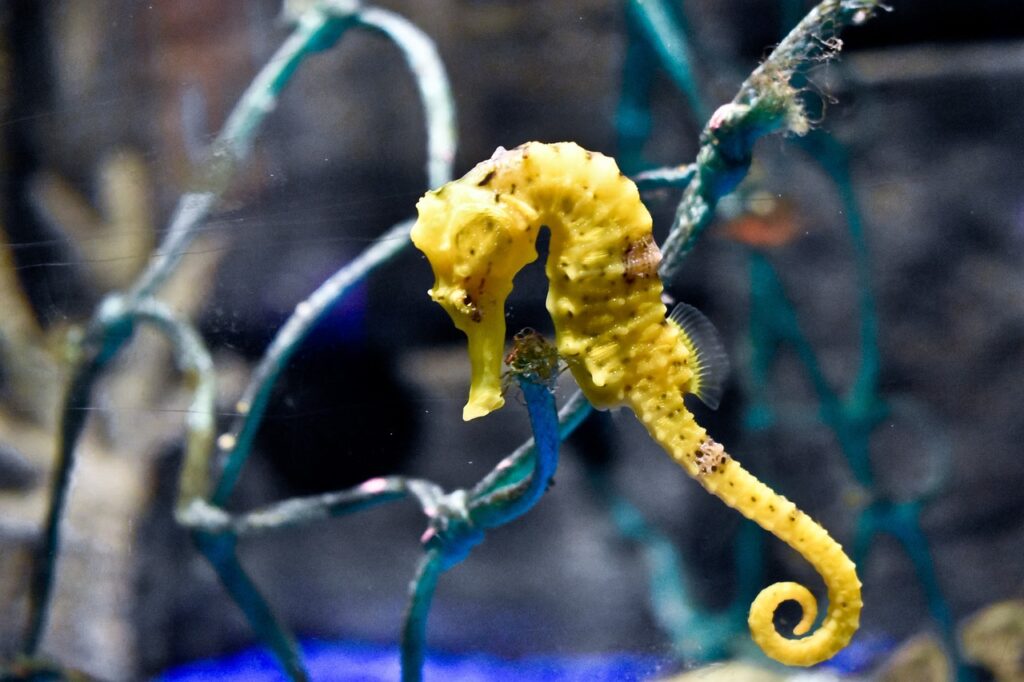
Male Seahorses and Their Role in Reproduction
One of the most interesting facts about seahorses is their unique reproductive cycle. Unlike most species, it is the male seahorse that becomes pregnant.
So male seahorses have a brood pouch located on their abdomen where females deposit their eggs. After fertilization, the male carries the eggs until they hatch, giving birth to tiny seahorse babies.
Courtship Dance and Pair Bonding
Seahorses are known for their elaborate courtship displays, which often include a synchronized dance.
Furthermore this courtship dance, performed by the male and female seahorses, strengthens their bond and ensures successful mating. During mating season, these displays become more frequent as seahorses prepare for reproduction.
Habitat and Distribution
Natural Habitat and Distribution
Seahorses inhabit a variety of marine environments, from shallow waters to temperate coastal regions.
For instance they are commonly found in coral reefs, seagrass beds, and among underwater plants. Surprisingly the diversity of seahorse species is vast, with different types of seahorses adapted to tropical and temperate waters alike.
Threats to Seahorses
Despite their adaptability, seahorses face numerous threats, primarily due to human impact. In fact the destruction of their habitat, climate change, and pollution are significant concerns.
Also Ocean trash, including single-use plastics, poses a severe threat to these fragile fish. Conservation efforts, such as those by the Seahorse Trust, aim to protect these unique creatures and their natural habitats.
Facts About Seahorses: Frequently Asked Questions
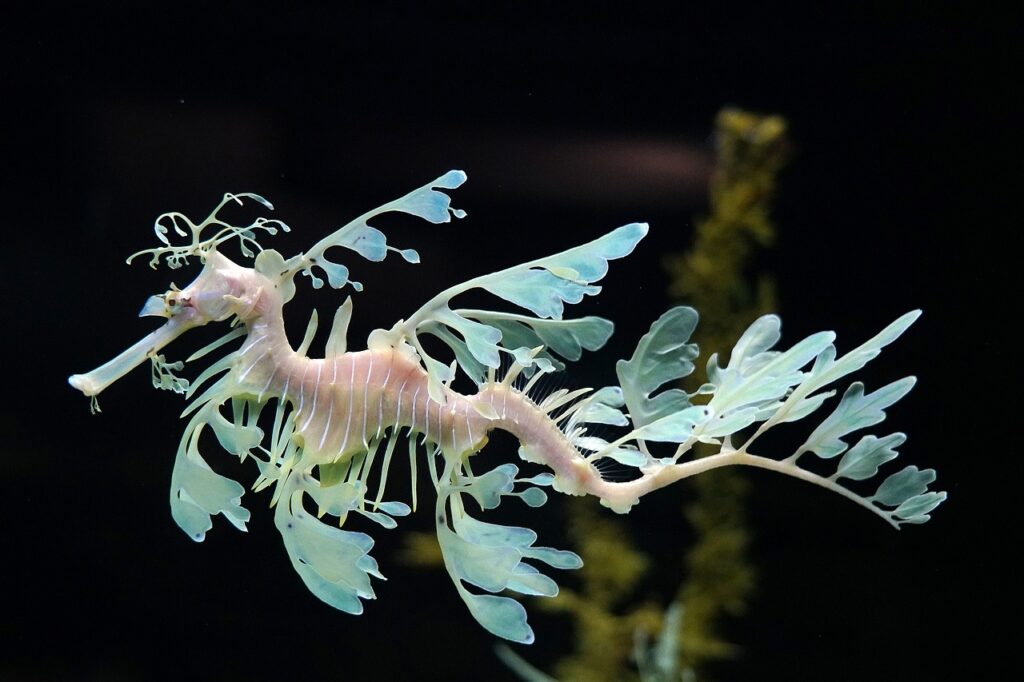
What is the scientific name of the seahorse?
The scientific name of the seahorse is Hippocampus, derived from the Greek words “hippos” (horse) and “kampos” (sea monster).
How do seahorses reproduce?
Seahorses reproduce through a unique process where the female deposits eggs into the male’s brood pouch, and the male carries the eggs until they hatch.
What do seahorses eat?
Seahorses primarily feed on small crustaceans, brine shrimp, and tiny pieces of food they can suck up with their elongated snouts.
Interesting Facts About Seahorses
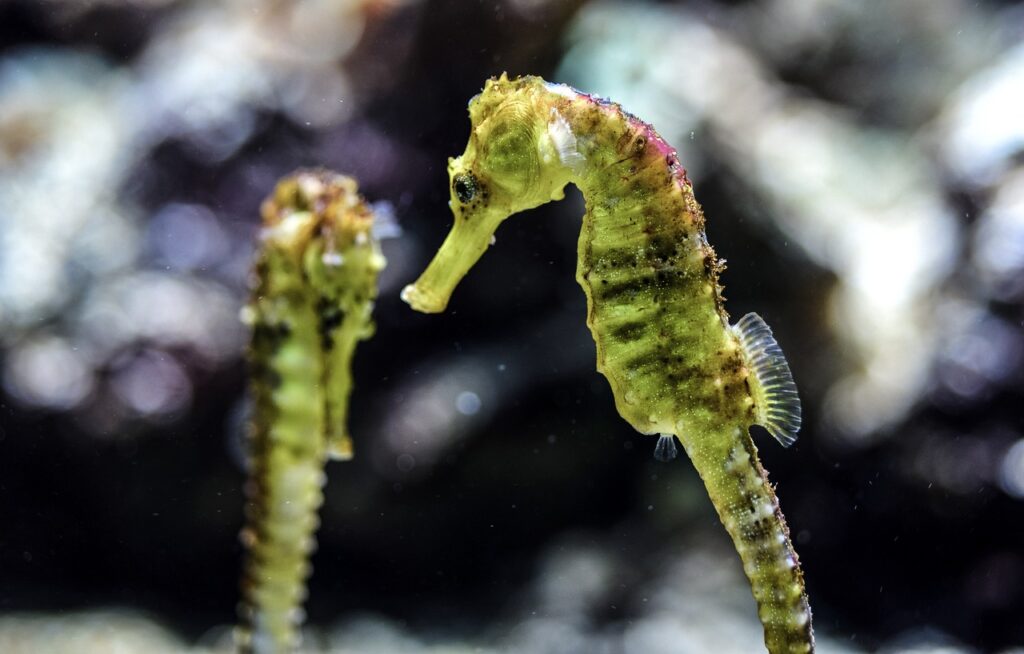
Seahorse Species Diversity
There are over 40 different species of seahorses, each with unique characteristics and adaptations. In fact some of the most notable species include the spiny seahorse, the big-bellied seahorse, and Satomi’s pygmy seahorse. These species vary in size, habitat, and coloration, contributing to the rich diversity of marine life.
Smallest and Largest Seahorse Species
Among the various seahorse species, the smallest is Satomi’s pygmy seahorse (Hippocampus satomiae), which measures just around 2 centimeters.
In contrast, the largest species, the big-bellied seahorse (Hippocampus abdominalis), can grow up to 35 centimeters. This wide range in size showcases the adaptability and evolutionary success of seahorses in different environments.
Adaptations for Survival
Poor Swimmers with Unique Swimming Techniques
Despite being poor swimmers, seahorses have developed unique techniques to navigate their environments. Their small dorsal fin, which flutters up to 35 times per second, allows them to move in a vertical position.
Meanwhile, their tiny pectoral fins help with steering. However, their slow swimming speed makes them susceptible to predators, reinforcing the importance of their ability to anchor themselves with their prehensile tails.
Camouflage and Mimicry
Seahorses possess remarkable camouflage abilities, blending into their surroundings to avoid predators.
Also, their bony plates and spiny appearance, combined with their ability to change color, make them masters of disguise.
Thus in seagrass beds and coral reefs, this camouflage helps them stay hidden from larger fish and other threats.
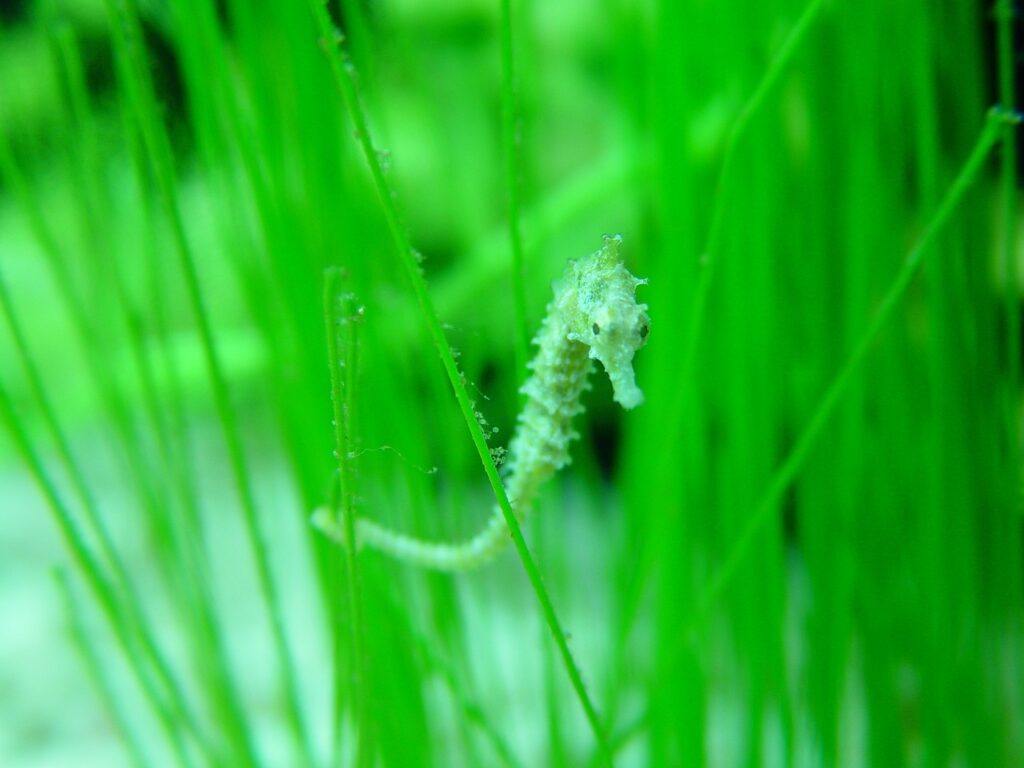
The Diet of Seahorses
Voracious Appetites and Hunting Techniques
Seahorses have voracious appetites, feeding primarily on small crustaceans, tiny fish, and pieces of food they can suck up with their elongated snouts.
Their digestive system is quite simple, and they lack a stomach, which means food passes through their bodies quickly. Therefore, they need to eat almost constantly to sustain themselves.
Feeding Habits and Preferences
Seahorses are often found in areas abundant with small crustaceans and brine shrimp, which are their preferred food sources.
These sea creatures use their tubular snouts to create a vacuum, effectively sucking in their prey. This method allows them to feed efficiently despite their limited mobility.
Reproduction and Life Cycle
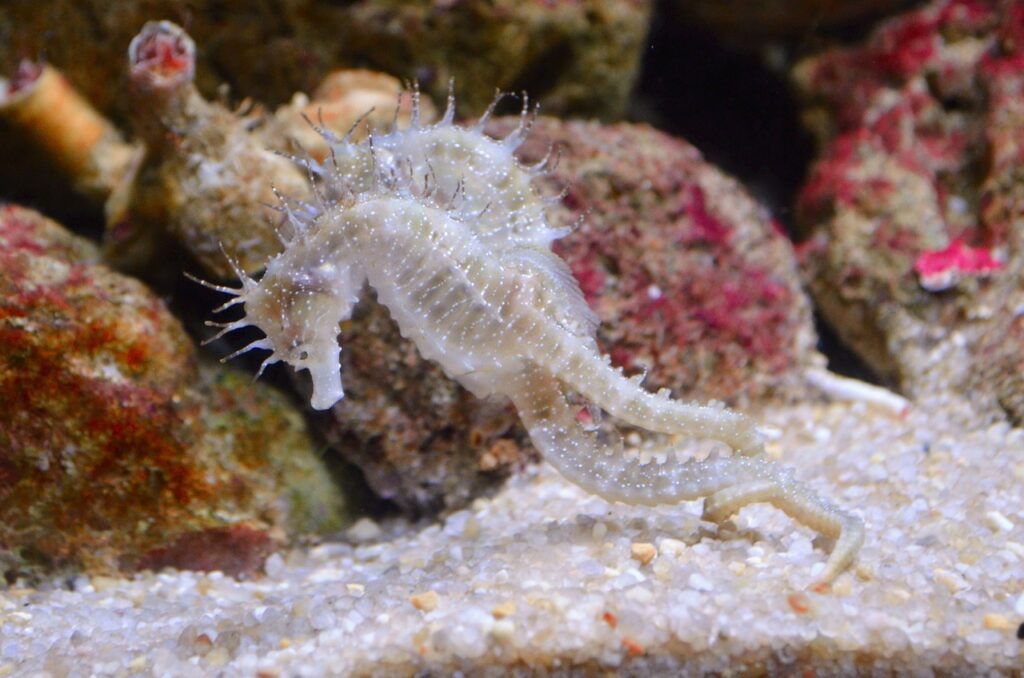
Elaborate Courtship Display
Seahorses engage in an elaborate courtship display that can last several days. This display involves synchronized swimming, color changes, and the iconic courtship dance.
This process not only strengthens the bond between the male and female but also synchronizes their reproductive cycles, ensuring successful fertilization.
Male Pregnancy and Birth
One of the most intriguing facts about seahorses is the role of males in reproduction. The female seahorse transfers her eggs to the male’s pouch, where he fertilizes and incubates them.
After a gestation period that can last from 10 days to six weeks, depending on the species, the male gives birth to fully formed baby seahorses, often in the hundreds. This unique reproductive strategy highlights the remarkable adaptability of seahorses.
Seahorses and Their Ecosystems
Role in Marine Ecosystems
Seahorses play a vital role in marine ecosystems. They are both predators and prey, contributing to the balance of marine food webs.
By controlling the population of small crustaceans and other tiny marine creatures, seahorses help maintain healthy coral reefs and seagrass beds.
Impact of Human Activities
Human activities have significantly impacted seahorse populations. Climate change, pollution, and the destruction of their natural habitats are some of the biggest threats they face.
The rise in ocean temperatures and the destruction of coral reefs have led to a decline in seahorse numbers.
Furthermore, seahorses are often captured for use in traditional medicine and the aquarium trade, further endangering their populations.
Conservation Efforts
Organizations like the Seahorse Trust are dedicated to the conservation of seahorses. These efforts include habitat protection, research, and advocacy to reduce the impact of human activities on seahorse populations.
Sustainable practices and increased awareness are essential to ensuring the survival of these unique marine creatures.
Threats and Conservation Efforts
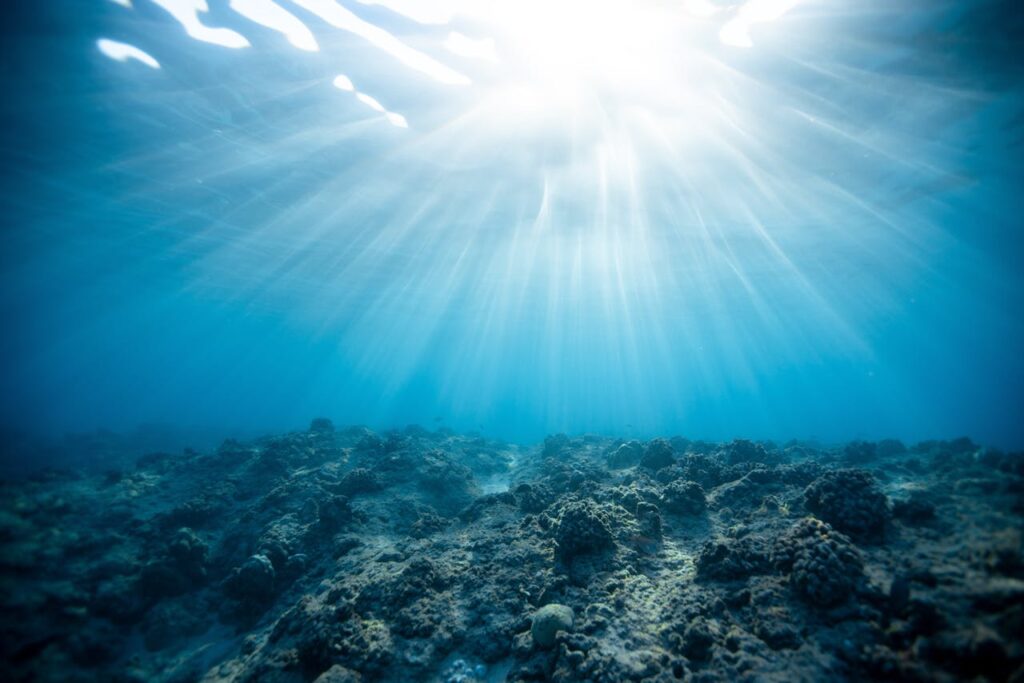
Climate Change and Habitat Destruction
Climate change poses a significant threat to seahorses. Rising ocean temperatures and acidification negatively affect coral reefs and seagrass beds, which are crucial habitats for seahorses.
Additionally, the destruction of these habitats due to coastal development and pollution further endangers their populations.
Overfishing and Bycatch
Seahorses often fall victim to overfishing and bycatch. In many regions, they are caught unintentionally in fishing nets targeting other species.
This incidental capture, coupled with targeted fishing for the traditional medicine and aquarium trades, has led to a severe decline in seahorse numbers.
Traditional Medicine and Aquarium Trade
In some cultures, seahorses are used in traditional medicine, believed to have various health benefits. This practice has led to the harvesting of millions of seahorses annually.
Moreover, their popularity in the aquarium trade has increased pressure on wild populations. Conservationists advocate for sustainable practices and stricter regulations to curb these activities.
Fun Facts About Seahorses
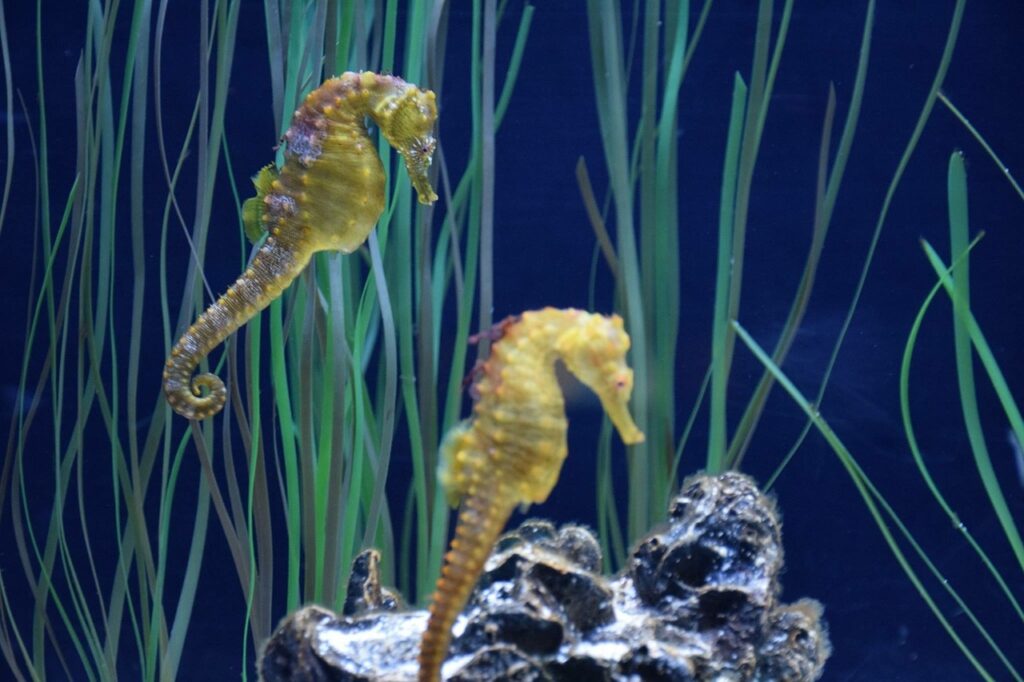
Seahorses Are Monogamous
One of the most charming facts about seahorses is their monogamous nature. Most seahorse species form a bond with a single partner, often lasting for life.
This pair bonding is reinforced through daily greetings and synchronized movements, showcasing their strong connection.
Unique Swimming Style
Seahorses swim in an upright position, a unique characteristic among fish. Their small fin on the back of their heads flutters rapidly to propel them through the water.
Despite their slow speed, this method allows them to maneuver with precision, particularly in the dense vegetation of their habitats.
The Slowest Fish in the Ocean
Seahorses hold the title for the slowest fish in the ocean. According to the Guinness World Records, the dwarf seahorse (Hippocampus zosterae) moves at a speed of about 1.5 meters per hour.
Their slow pace makes them easy targets for predators, but their excellent camouflage offers some protection.
Seahorse Eyes Work Independently
Seahorses have the remarkable ability to move their eyes independently of each other. This trait allows them to scan their surroundings for food and potential threats simultaneously. This ability is especially useful in their complex, densely vegetated habitats.
Seahorses and Human Impact
Conservation Organizations
Conservation organizations like Project Seahorse and the Seahorse Trust are dedicated to studying and protecting seahorse populations. These groups work on various fronts, including habitat protection, research, and policy advocacy.
Through their efforts, they aim to mitigate the impacts of human activities on seahorse populations and promote sustainable practices.
Importance of Sustainable Practices
Adopting sustainable practices is crucial for the survival of seahorses. Reducing the carbon footprint, minimizing ocean trash, and implementing sustainable fishing methods can significantly impact the health of marine ecosystems.
Public awareness and education play vital roles in promoting these practices and ensuring the longevity of seahorse populations.
Facts About Seahorses: Frequently Asked Questions
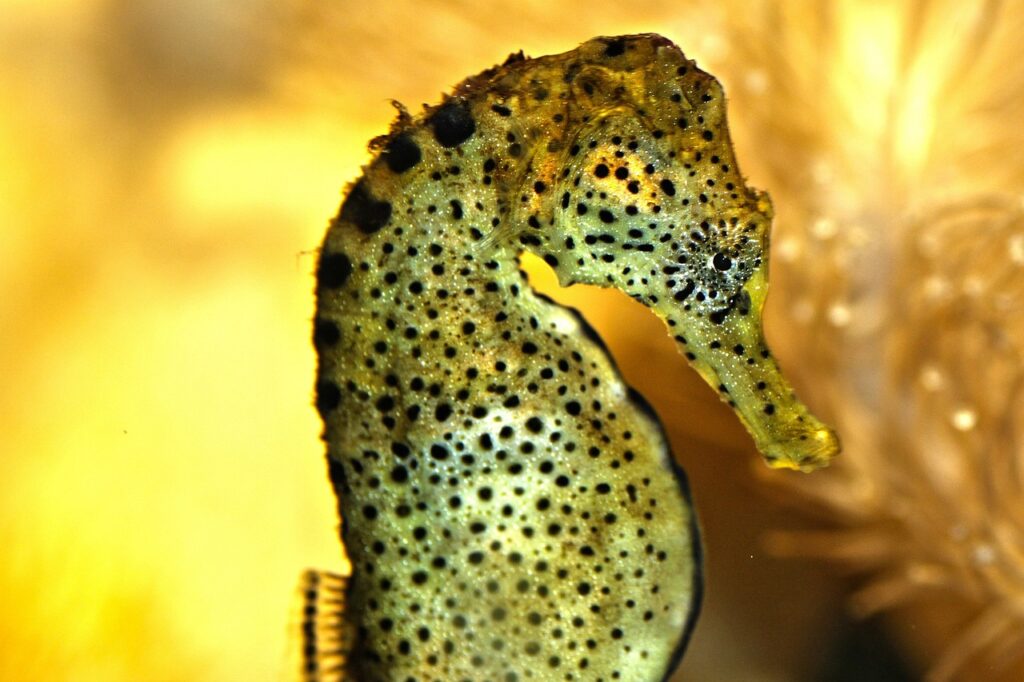
How long do seahorses live?
Seahorses have varying lifespans depending on the species. On average, they live for one to five years. Factors such as habitat, diet, and predation influence their longevity.
Are seahorses endangered?
Many seahorse species are listed as vulnerable or endangered due to threats like habitat destruction, overfishing, and climate change. Conservation efforts are essential to protect these unique creatures.
Can seahorses change color?
Yes, seahorses can change color to blend in with their surroundings. This ability helps them avoid predators and communicate with other seahorses during courtship and territorial displays.
What is the biggest threat to seahorses?
The biggest threats to seahorses include habitat destruction, climate change, and overfishing. Conservation organizations are working to address these challenges through research, advocacy, and habitat protection.
How do seahorses protect themselves from predators?
Seahorses rely on their camouflage abilities and bony plates to protect themselves from predators. Their spiny appearance and ability to blend into their surroundings provide a significant defense mechanism.
Facts About Seahorses Conclusion
Seahorses are extraordinary marine creatures with unique characteristics and behaviors. Their fascinating reproductive cycle, distinctive anatomy, and vital role in marine ecosystems make them a subject of great interest.
However, they face numerous threats due to human activities. Understanding these threats and supporting conservation efforts are crucial for ensuring the survival of seahorses.
By promoting sustainable practices and raising awareness, we can help protect these enchanting creatures for future generations.
Conservation Efforts and Future Outlook
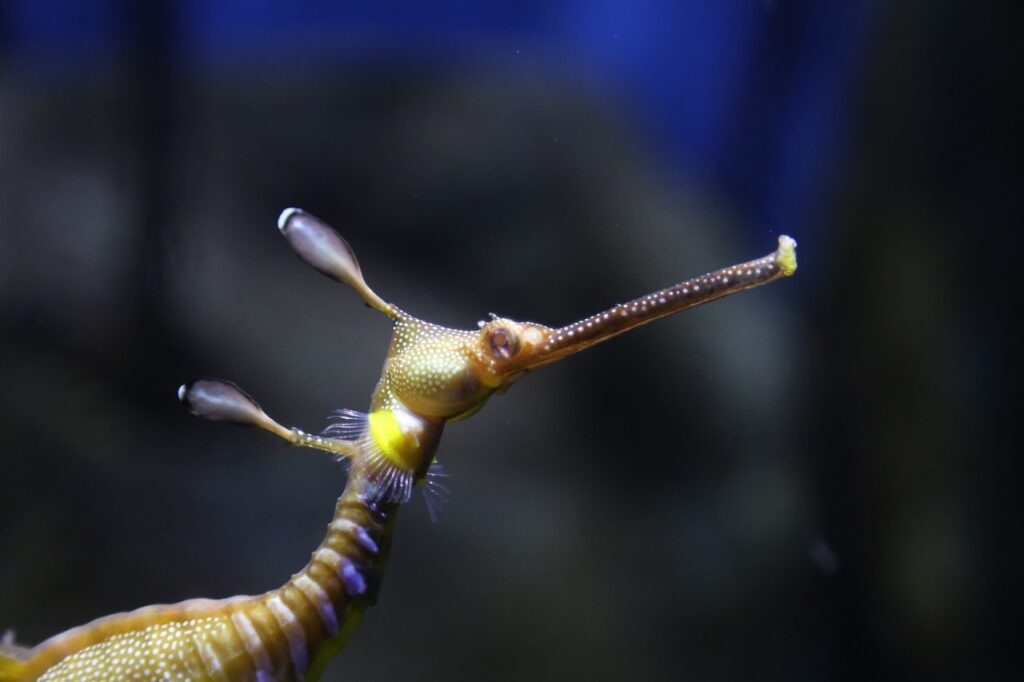
Marine Protected Areas
One effective strategy for protecting seahorses is the establishment of marine protected areas (MPAs).
These regions, often managed by governmental or non-governmental organizations, restrict human activities that can harm marine life.
By creating safe havens where seahorses can live and reproduce without the threat of fishing, pollution, or habitat destruction, MPAs play a crucial role in conservation efforts.
Research and Monitoring
Ongoing research and monitoring are vital for understanding seahorse populations and their ecosystems.
Scientists track seahorse numbers, study their behaviors, and assess the health of their habitats. This information helps guide conservation policies and practices.
Collaborative efforts between researchers, conservationists, and local communities are essential for the long-term survival of seahorses.
Related Article, Interesting Facts About Marine Biologists
Community Involvement and Education
Engaging local communities in conservation efforts is key to success. Educating people about the importance of seahorses and the threats they face can foster a sense of stewardship.
Community-based conservation programs, such as sustainable fishing practices and habitat restoration projects, empower locals to protect their marine resources.
Fascinating Facts About Seahorses
Seahorses and Their Ecosystem Roles
Seahorses are important indicators of the health of marine ecosystems. Their presence in a habitat often signifies a well-balanced environment with adequate food sources and minimal pollution.
Protecting seahorses, therefore, contributes to the overall health of marine ecosystems.
Seahorse Communication
Seahorses communicate through subtle movements and color changes. During courtship, they perform complex dances and synchronize their movements.
These behaviors are not only fascinating to observe but also crucial for successful reproduction.
Seahorse Trust Initiatives
The Seahorse Trust is a leading organization in the fight to protect seahorses. They conduct research, promote conservation education, and work with governments and other organizations to implement protective measures.
As I have said their initiatives include habitat restoration, monitoring seahorse populations, and advocating for stronger environmental policies.
Seahorses in Traditional Medicine
In traditional medicine, particularly in Asia, seahorses are believed to possess medicinal properties. This belief has led to the harvesting of millions of seahorses annually.
Conservationists are working to reduce the demand for seahorses in traditional medicine by promoting sustainable alternatives and raising awareness about the ecological impact of this practice.

Facts About Seahorses Conclusion
Finally seahorses are among the most captivating marine species, with their unique anatomy, reproductive behavior, and ecological roles.
Despite their slow swimming abilities and vulnerability, they have adapted remarkably well to their environments.
However, human activities such as habitat destruction, climate change, and overfishing pose significant threats to their survival.
Indeed protecting seahorses requires a multifaceted approach, involving research, conservation efforts, and community engagement.
So by supporting organizations like the Seahorse Trust and adopting sustainable practices, we can help ensure the future of these enchanting creatures.
Moreover increased awareness and education about the importance of seahorses and the challenges they face are essential for fostering a sense of responsibility and action among individuals and communities.
In summary, the fascinating facts about seahorses reveal not only their unique place in the marine world but also the urgent need for concerted conservation efforts.
Consequently these delicate yet resilient creatures serve as a reminder of the intricate and interconnected nature of our ecosystems and the impact of our actions on the natural world.
Now read my Awesome Fun Facts About Starfish



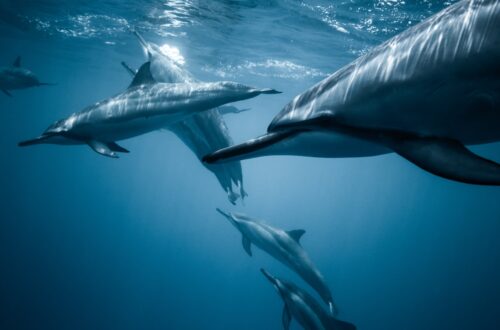

2 Comments
Pingback:
Pingback: